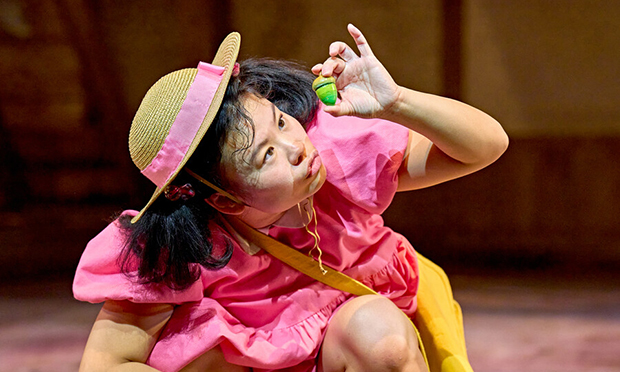My Neighbour Totoro, Barbican, stage review: ‘A germinating, blossoming, unfurling delight’

Photograph: Manuel Harlan / RSC, with Nippon TV
Innocence. A fleeting thing, silver like moonlight and in short supply at times like these.
Improbable Theatre, a company headed by director Phelim McDermott in partnership with original Studio Ghibli composer Joe Hisaishi, has done the, well, improbable.
They have turned Hayao Miyazaki’s 1988 animation My Neighbour Totoro into a glorious theatre reality, bringing to life this drawn tale of childhood wonder.
Famous Japanese animation house Studio Ghibli traded partly in the commodity of innocence. The early films in its roster rejoice in the importance of the natural world through the eyes of the young.
Things darken later, and layers of menace crept in during the late 90s (ironically bringing international fame) with films such as Spirited Away and Princess Mononoke. But the interplay between childhood and adulthood, nature and civilisation stayed throughout.
In the countryside of 1950s Japan, a father moves his young family from the city to be close to their mother in the hospital. The girls, Mei (Mei Mac) and Satsuki (Ami Okumura Jones), embark on a tale of spirit and spirits, as they deal with sickness, sisterhood, and loneliness in their new home. That’s the beauty of the story, its simplicity.
However, drawing something (although taking much artistic skill) is very different to bringing it to life in the world of theatre.
Plonking ourselves down, even the first five minutes are divine, as the fluffy mop-looking title letters start to bounce and sing on a flat blue background. It produces squeals of delight from the children in the audience. We are in safe hands and I breathe a sigh of relief.
Tom Pye’s set uses every inch of the cavernous Barbican theatre. The traditional Minka house sits in the centre of a nifty revolving stage, around it the gnarled tendrils of the woods are more than just a decorative backdrop. Twisting themselves into platforms, they hold aloft the back of the stage, where the orchestra and Japanese singer-songwriter Ai Ninomiya sit. It is a clever way to have the musicians (bringing to life Hisaishi’s soaring score) within the world, while leaving the rest of the stage free for action.
Pye’s mix of stylistic two-dimensional scene changes with very three-dimensional set pieces is a loving nod to the tale’s pen-on-paper origins.
The faithfulness to the anime doesn’t stop there (thankfully).
Joe Hisaishi as the composer and executive producer is the driving force and reason we are seeing this show at all. Bringing his Ghibli mindset and scores to the RSC and Improbable, he has crafted something entirely its own yet lovingly true to the original film.
The cast understands this duality, both Mac and Okumura Jones allow the extreme physicality and vocal work in the film to inform their performances. They not only become very believable children but also remind us of the style the studio is so well known for.
Some actors, although skilled, find this difficult to deal with, such as Dai Tabuchi as the girls’ father Tatsuo. But overall the tale keeps its wonder without devolving into sentimentality or melodrama.
What about the infamous neighbour? Totoro himself marked a move to financial stability for the studio. Toys of his likeness kick-started the branching out into other avenues that now include adverts, computer animation and a theme park opening in November outside Tokyo.
To create Totoro for the play, the team behind the production turned to acclaimed puppeteer Basil Twist.
In many other shows – 2018’s A Monster Calls at the Old Vic for one – everyday objects and clever lighting are used to craft these large magical beings, with varying degrees of effectiveness. In this case, no such combination technique is needed. When Mei first meets Totoro in the forest, a gasp ripples around the auditorium.
Looking like a gigantic Snorlax, the puppet is breathing, inflated, and so humongous that Mei can sit on his chest. The fluffy owl-badger-woodland-water-bottle has a massive pink red mouth and a moving tongue and looks alive. It is puppetry that crafts magic out of mechanics. His eyes swing around, claws curl, and lips rise expressively. Don’t even get me started on the glowing cat bus! Like a golden zeppelin, but much more fun, it glides off and on stage, bathing us in a sunset of light and movement.
This is a triumph for the theatre company and the director, as having created a “huge-hearted ensemble spirit”, the proof is very much in the mochi. Whether it’s the set changes in which farmers pull on crops attached to their sandals, or Kimie Nakano’s bright, brash, perfect period costumes, everyone is pulling together to do justice to a seminal piece of animated film.
As Mei and Satsuki plant acorns to cheer up their mother, and wait patiently for them to grow only to see them burst dramatically into life thanks to Totoro’s mystical scream, we are reminded of the complexity inside this simple story.
Only the girls can see the fuzzball, yet through this friendship, they learn about themselves and the world.
This piece is a reminder of the things we can sometimes forget as adults – love, friendship and reverence for nature.
The first of the big Christmas shows is a germinating, blossoming, unfurling delight, filled with subtle environmental and social commentary.
Maybe we could all do with a neighbour like Totoro?

Is it ending at chapter 50?